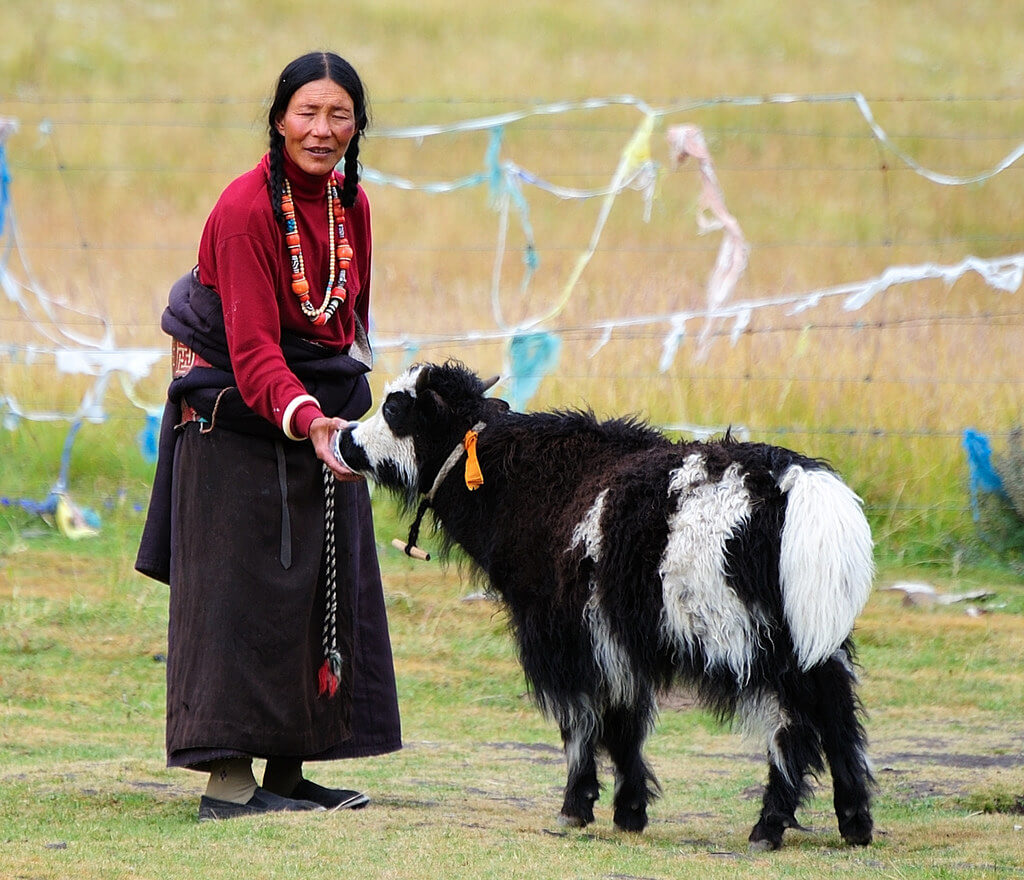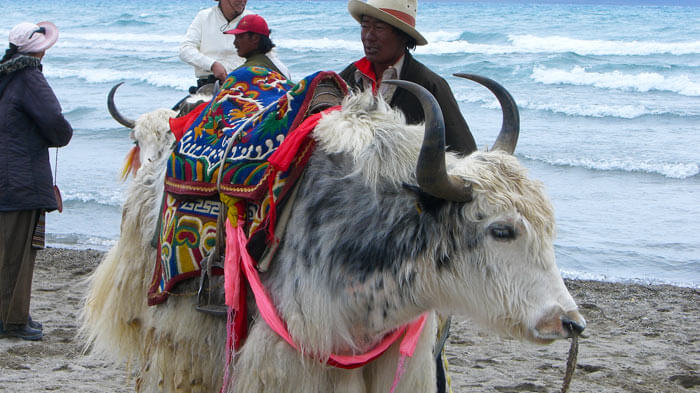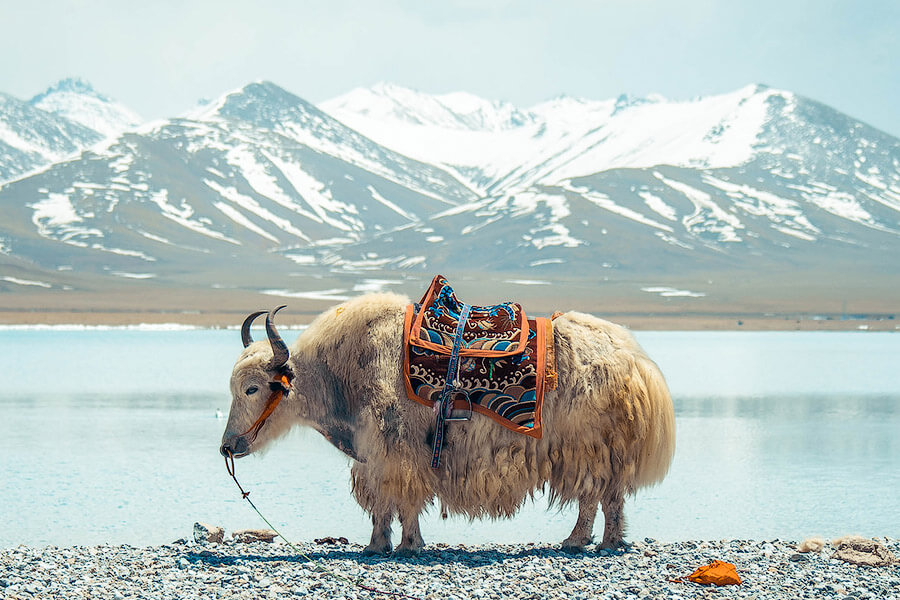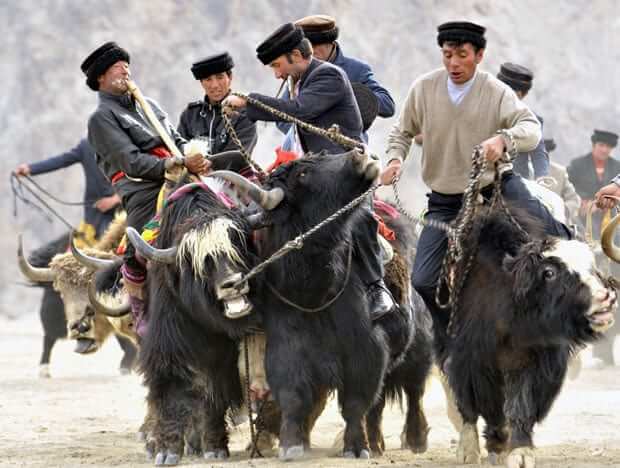Domestic yak

The domestic yak is a long-haired domesticated bovid found throughout the Himalayan region of the Indian subcontinent, the Tibetan Plateau, Northern Myanmar, Yunnan, Sichuan and as far north as Mongolia and Siberia. It is descended from the wild yak.
The English word “yak” is a loan originating from Tibetan. In Tibetan and Balti, it refers only to the male of the species, the female being called, Wylie Wylie in Tibetan. In English, as in most other languages that have borrowed the word, “yak” is usually used for both sexes, with “bull” or “cow” referring to each sex separately.
Yaks belong to the genus Bos and are therefore related to cattle.
The yak may have diverged from cattle at any point between one and five million years ago, and there is some suggestion that it may be more closely related to bison than to the other members of its designated genus. Apparent close fossil relatives of the yak, have been found in eastern Russia, suggesting a possible route by which yak-like ancestors of the modern American bison could have entered the Americas.
Yaks are heavily built animals with a bulky frame, sturdy legs, rounded cloven hooves, and extremely dense, long fur that hangs down lower than the belly. While wild yaks are generally dark, blackish to brown in colouration, domestic yaks can be quite variable in colour, often having patches of rusty brown and cream. They have small ears and a wide forehead, with smooth horns that are generally dark in colour. In males (bulls), the horns sweep out from the sides of the head and then curve forward. Both sexes have a short neck with a pronounced hump over the shoulders, although this is larger and more visible in males. Males weigh 350 to 585 kg (772 to 1,290 lb), females weigh 225 to 255 kg (496 to 562 lb). Wild yaks can be substantially heavier, bulls reaching weights of up to 1,000 kilograms (2,200 lb). Depending on the breed, domestic yak males are 111–138 centimetres (44–54 in) high at the withers, while females are 105–117 centimetres (41–46 in) high at the withers.

Both sexes have long shaggy hair with a dense woolly undercoat over the chest, flanks, and thighs to insulate them from the cold. Especially in bulls, this may form a long “skirt” that can reach the ground. The tail is long and horselike rather than tufted like the tails of cattle or bison. Domesticated yaks have a wide range of coat colours, with some individuals being white, grey, brown, roan or piebald. The udder in females and the scrotum in males are small and hairy, as protection against the cold. Females have four teats.
Yaks grunt and, unlike cattle, are not known to produce the characteristic bovine lowing (mooing) sound, which inspired the scientific name of the domestic yak variant, Bos grunniens (grunting bull). Nikolay Przhevalsky named the wild variant (silent bull), believing that it did not make a sound at all.
Contrary to popular belief, yak and their manure have little to no detectable odour when maintained appropriately in pastures or paddocks with adequate access to forage and water. Yak’s wool is naturally odour resistant.

Yaks mate in the summer, typically between July and September, depending on the local environment. For the remainder of the year, many bulls wander in small bachelor groups away from the large herds, but, as the rut approaches, they become aggressive and regularly fight among each other to establish dominance. In addition to non-violent threat displays, bellowing, and scraping the ground with their horns, bull yaks also compete more directly, repeatedly charging at each other with heads lowered or sparring with their horns. Like bison, but unlike cattle, males wallow in dry soil during the rut, often while scent-marking with urine or dung. Females enter oestrus up to four times a year, and females are receptive only for a few hours in each cycle.
Gestation lasts between 257 and 270 days, so that the young are born between May and June, and results in the birth of a single calf. The cow finds a secluded spot to give birth, but the calf can walk within about ten minutes of birth, and the pair soon rejoin the herd. Females of both the wild and domestic forms typically give birth only once every other year, although more frequent births are possible if the food supply is good.

Calves are weaned at one year and become independent shortly thereafter. Wild calves are initially brown, and only later develop the darker adult hair. Females generally give birth for the first time at three or four years of age and reach their peak reproductive fitness at around six years. Yaks may live for more than twenty years in domestication or captivity, although it is likely that this may be somewhat shorter in the wild.
Domesticated yaks have been kept for thousands of years, primarily for their milk, fibre and meat, and as beasts of burden. Their dried droppings are an important fuel, used all over Tibet, and are often the only fuel available on the high treeless Tibetan Plateau. Yaks transport goods across mountain pass for local farmers and traders as well as for climbing and trekking expeditions. “Only one thing makes it hard to use yaks for long journeys in barren regions. They will not eat grain, which could be carried on the journey. They will starve unless they can be brought to a place where there is grass.” They also are used to draw ploughs. Yak’s milk is often processed to a cheese called chhurpi in Tibetan and Nepali languages, and byaslag in Mongolia. Butter made from yaks’ milk is an ingredient of the butter tea that Tibetans consume in large quantities and is also used in lamps and made into butter sculptures used in religious festivities.
Also Read.
How to Recognise Native British Cattle Breeds | The American Bison | Recognized indigenous cattle breeds of India | List of Bos Indicus Breeds – Zebu Breed | First Domesticated Cattle in the World : Origin of Modern Cows Traced | 40 million cows to get Aadhaar like number at cost of Rs 50 crore in 1st phase : Budget 2018 | Registration of livestock/poultry breeds rises to 169: Govt | Chennai to host expo of indigenous native cattle breeds on Jan 6 and 7. | Kerala Sets up a special reproduction centre to help grow Vechur cattle population | Andhra pradesh well poised to become a seed hub, says Bill Gates | Using Cow Dung of Indigenous Breeds, This Farmer Makes Lakhs from Organic Papaya | Kampala to host 2017 livestock show | Cargill to plough millions into animal nutrition business in India | Supreme Court issues notice to Tamil Nadu government on PETA plea against jallikattu | Haryana govt plans PGs for cattle to boost milk production | Molecular Characterisation of Rathi and Tharparkar Indigenous Cattle (Bos indicus) | Embryo transfer technology to be used to carry out 440 embryo transfers in cattle in 9 days | ‘Rettamalai Ondikaruppu’ Temple Bull , is no more | Decline in indigenous cow breeds: NGT summons official | Maharashtra moos to boost desi/Indigenous cow varieties | Soon desi cow’s milk will be sold through medical stores: Warns Rajasthan minister | Telangana ties up with Brazil to improve Desi milk production | Project Mooo: supporting India’s dairy farmers with sustainable technology | Government allocates ₹2.5 cr. for protection of native cattle breeds | Project to preserve indigenous cattle – Karnataka.| Alanganallur was the most crowded village today in India! | Tamils Gathered in America, To show Support Jallikattu!! |
Native breed cattle.
For More information and purchase on different indigenous breeds
Alambadi Cattle | Amrit Mahal Cattle | Bachaur cattle | Bargur Cattle | Gir Breed
Kasaragod Dwarf Cattle | Kherigarh Cattle | Krishna Valley cattle | Malnad Gidda Cattle
Mewati Breed | Ongole breed cattle | Ponwar Breed | Pulikulam Cattle
Umblachery Cattle | Vechur Cattle Breed
Native Dog breed.
For More information on Indian native dog breeds.
Banjara Greyhound | bully kutta mastiff | Chippiparai Hound | Gaddi Kutta mastiff
Indian Spitz | jonangi breed | kanni hound dog | Kombai/Combai hound dog | Mudhol Hound